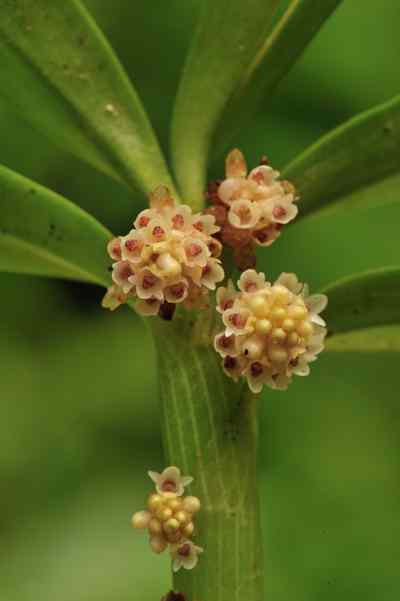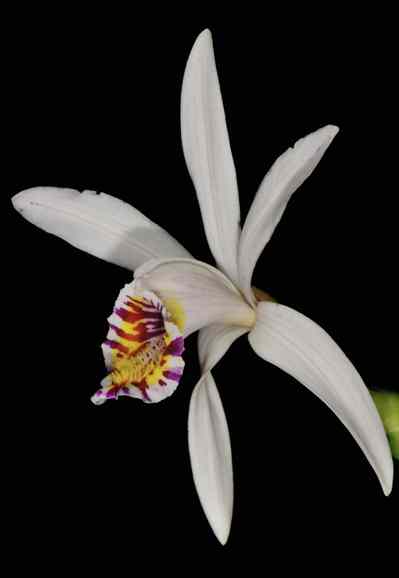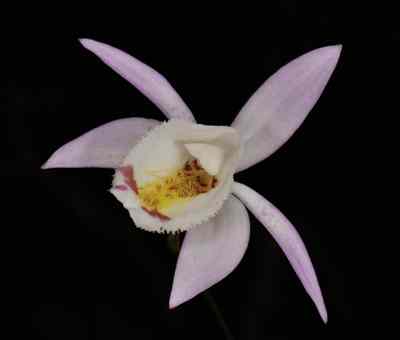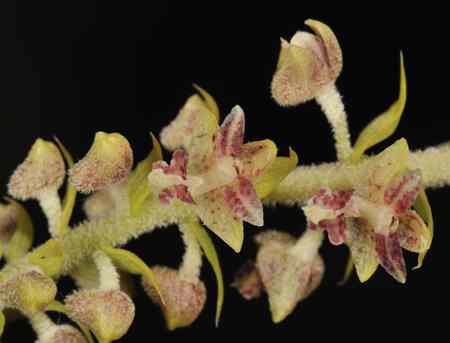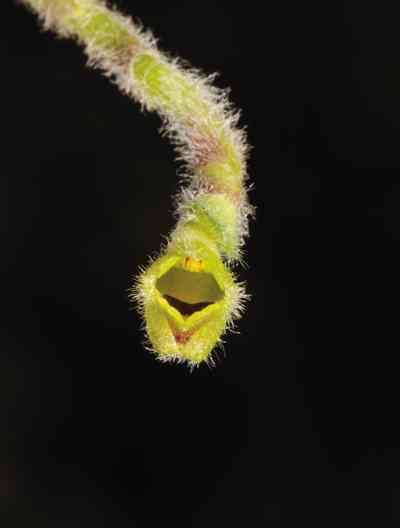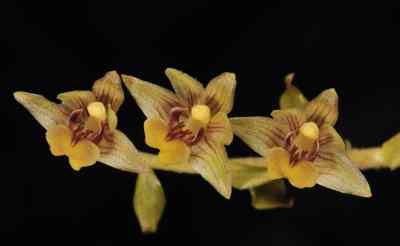The Plant
Terrestrial. Whole plant between 2 to 2.5 ft high, with the lower one third being the stem and the rest the flowering spike. Stem stout with 2 or 3 wide blunt sheaths on its lower portion and 5 to 8 leaves in a whorl around its apex. Leaves ovate-elliptic, upper and lower ones relatively smaller than the others, 4 to 7 cm long and 2 to 2.5 cm in width, acute, long sheathed and clasping, with noticeable veins and broad pale yellow margins. Spike with 2 or 3 lanceolate and acuminate bracts. Tuber oblong, hairy, 2 to 5 cm long and 1 cm in cross section.
The Flower
Flowers many and densely arranged in a spike, each 1.5 to 2 cm across. Sepals sub-equal, lateral three times longer than the dorsal; dorsal broad, lanceolate and arching; lateral pair spreading, oblong, obtuse, with undulate margins and folded inwardly. Petals larger than the dorsal sepal, obliquely ovate, lanceolate, with a winged outward extension on its base, internal edges slightly overlapping. Lip longer than the lateral sepals, three lobed; oblong with blunt apex, side lobes slightly longer than the middle one but narrow, lobes three veined. Spur very small, globular. Bracts erect, lanceolate, acuminate, longer than the ovary.
Sepals pale brownish pink with very minute white margins. Petals pure white. Bracts greenish brown.

The Pursuit
One of the beautiful terrestrial orchids of Sikkim-Himalayas. It was once a common species, presently on the verge of extinction due to habitat loss and over collection from the region. Even though several researchers had documented this species, it took me more than three years to find it from its natural habitat.
I was aware about its blooming cycle from various century old publications. The plant appears along with the early monsoon showers and blooms within a month. I was concentrating for this species on both the banks of river Teesta. During the pursuit of this species I was able to cross over the river Teesta several times at different locations, even during the monsoons. Several of its earlier habitats were destroyed due to construction of dams over the river Teesta.
The day I found this species of the find of this species, I got a good company in the form of a Forest Guard who was earlier posted in that region. He had made many treks inside those forests to trace out poachers; hence he was very familiar about river crossing and the general geography of the region. He guided me very well inside the deep forest and we did a long day of survey finding many species including six young plants of this species. The plants were still so young, my initial calculation was that it would take another 15 to 20 days for them to bloom. The Forest Guard promised that he would try to accompany me in my next trip also. After two weeks when I contacted him, he was attending an official training program, which would not be over in another 10 days; hence I was left alone with the pursuit. As I was aware about the fact, that when the dams over the river Teesta were fully functional I will never be able to cross to the other side and will hopefully never see this plant again, made me undertake the trip all by myself the very next day. The first part of the journey – crossing the river was done without much difficulty. But, inside the forest I lost the track of those six plants. I attempted different tracks and location, but was unable to locate those plants. Totally disappointed I returned to my camp. On the next day also, I tried without any success. In between I found some other species, but for what I went there remained elusive.
After a week, my good friend called me and said he is back home from training and ready to make a trip. I reached his home the next day as early as I could and immediately left for the search. After around 1 hr and 45 minutes of walk, much before the location of those six plants we sighted earlier, we found two new specimens of the species in full bloom. It was a wonderful sight to see this almost pure white flower in full bloom with the green foliage in background. Interestingly, in my two previous visits I took a break of more than 15 minutes at that same location but had failed to spot them. We decided to skip the other habitat and document the present ones and shot this beautiful photograph of the species.
Now, with the dam fully functional and river water up by more than 30 to 40 ft, the entire region is under water, bringing death to thousands of plant species and the main river of the Sikkim-Himalayas.
Reference:
Habenaria constricta Wall. ex Hook., Page no 325 – 326 of The Orchids of the Sikkim-Himalayas by Sir. George King and Robert Pantling (1898).
